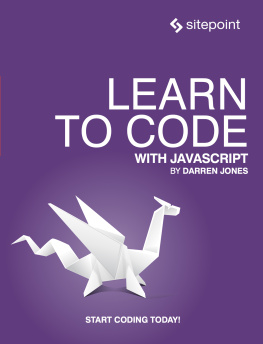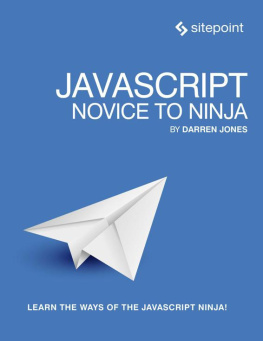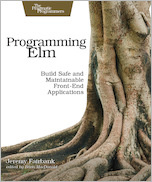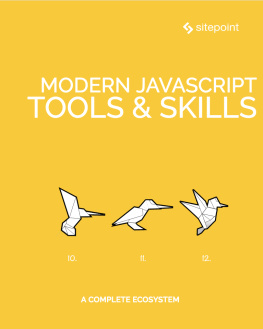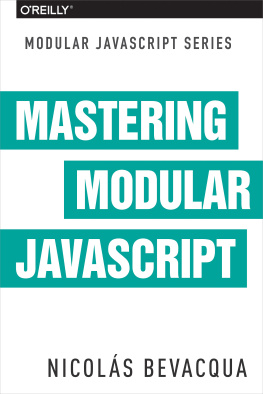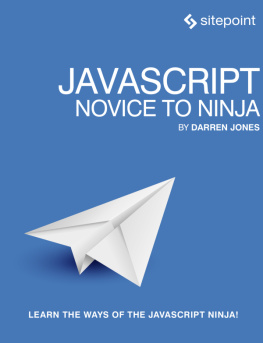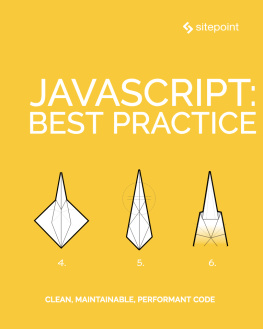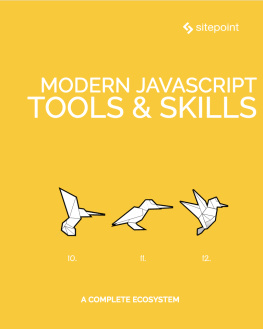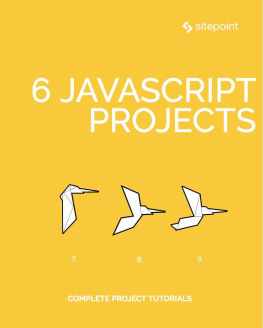Darren Jones - Learn to Code With JavaScript
Here you can read online Darren Jones - Learn to Code With JavaScript full text of the book (entire story) in english for free. Download pdf and epub, get meaning, cover and reviews about this ebook. year: 2017, publisher: SitePoint, genre: Home and family. Description of the work, (preface) as well as reviews are available. Best literature library LitArk.com created for fans of good reading and offers a wide selection of genres:
Romance novel
Science fiction
Adventure
Detective
Science
History
Home and family
Prose
Art
Politics
Computer
Non-fiction
Religion
Business
Children
Humor
Choose a favorite category and find really read worthwhile books. Enjoy immersion in the world of imagination, feel the emotions of the characters or learn something new for yourself, make an fascinating discovery.
- Book:Learn to Code With JavaScript
- Author:
- Publisher:SitePoint
- Genre:
- Year:2017
- Rating:4 / 5
- Favourites:Add to favourites
- Your mark:
- 80
- 1
- 2
- 3
- 4
- 5
Learn to Code With JavaScript: summary, description and annotation
We offer to read an annotation, description, summary or preface (depends on what the author of the book "Learn to Code With JavaScript" wrote himself). If you haven't found the necessary information about the book — write in the comments, we will try to find it.
Learn to Code With JavaScript — read online for free the complete book (whole text) full work
Below is the text of the book, divided by pages. System saving the place of the last page read, allows you to conveniently read the book "Learn to Code With JavaScript" online for free, without having to search again every time where you left off. Put a bookmark, and you can go to the page where you finished reading at any time.
Font size:
Interval:
Bookmark:
Copyright 2021 SitePoint Pty. Ltd.
Ebook ISBN: 78-1-925836-41-7
- Product Manager: Simon Mackie
- Technical Editor: James Hibbard
- English Editor: Ralph Mason
- Cover Designer: Alex Walker
All rights reserved. No part of this book may be reproduced, stored in a retrieval system or transmitted in any form or by any means, without the prior written permission of the publisher, except in the case of brief quotations embodied in critical articles or reviews.
The author and publisher have made every effort to ensure the accuracy of the information herein. However, the information contained in this book is sold without warranty, either express or implied. Neither the authors and SitePoint Pty. Ltd., nor its dealers or distributors will be held liable for any damages to be caused either directly or indirectly by the instructions contained in this book, or by the software or hardware products described herein.
Rather than indicating every occurrence of a trademarked name as such, this book uses the names only in an editorial fashion and to the benefit of the trademark owner with no intention of infringement of the trademark.

Published by SitePoint Pty. Ltd.
48 Cambridge Street Collingwood
VIC Australia 3066
Web: www.sitepoint.com
Email: books@sitepoint.com
SitePoint specializes in publishing fun, practical, and easy-to-understand content for web professionals. Visit http://www.sitepoint.com/ to access our blogs, books, newsletters, articles, and community forums. Youll find a stack of information on JavaScript, PHP, design, and more.
Darren has enjoyed coding since learning how to program in BASIC on his first Acorn Electron computer. Since then, hes taught himself Ruby and JavaScript and is the author of JavaScript: Novice to Ninja and Jump Start Sinatra. He also produced the Getting Started With Ruby video tutorials for SitePoint Premium and has written a number of articles on the SitePoint website. He was born in the city of Manchester in the UK, where he still lives, and he teaches Mathematics and Computing at a local high school. You can find him on Twitter @daz4126.
I still remember my first ever computer: it was an Acorn Electron, and I loved using it to play games such as Sphinx Adventure (a text-based adventure), Starship Command (a hard-as-nails shoot-em-up) and Chuckie Egg (pure platform action). But the real fun started when I realized that I could write my own code in a language called BASIC. My initial thoughts were that it had been named ironically, as it appeared to be anything but basic. It had line numbers that went up in multiples of ten and strange-sounding commands such as GOTO, REM and CLS that just looked like gobbledygook at first. But with lots of practice (and many mistakes), it started to make sense and I became fascinated by how the code allowed me to control what the computer did. I would spend hours copying code examples out of magazines (yes, it was that long ago!) and then play around making my own modifications. It was this experimentation and tinkering with code that helped me understand how it worked. I had been well and truly bitten by the coding bug.
My enjoyment of coding comes from the fact that it requires you to follow the precise rules of the programming language while also encouraging you to think creatively to achieve your desired outcome. The essence of coding is turning the abstract into the practical. When I set about writing this book, my aim was to introduce the basic concepts of coding and back the theory up with plenty of practical examples. Each chapter ends with coding challenges that will help consolidate your understanding. I encourage you to really dig into these challenges by not only trying to complete them, but also trying to extend them with your own modifications.
It was always games that I wanted to program, and Ive tried to make as many of the challenges in the book as fun as possible, both to code and to play. And by the end of the book, youll have coded a couple of fully playable games. Youll also have the foundations in place for creating interactive websites and be on the right path to writing full-scale applications.
Programming is a creative endeavor; its fundamentally about creating things. You need your code to be precise and concise, but you also need to inject it with some flair to make it come alive. This mix of precision and ingenuity is what continues to make coding enjoyable for me, many years after starting out on my Acorn Electron. My hope is that this book will inspire you to start coding and that youll continue to enjoy it for a long time after youve finished reading the last page.
This book is for people with no prior programming experience who would like to learn how to code. We use JavaScript in this book to teach you, so at the end you'll have a good understanding of JavaScript, but you can apply the principles youve learned to other programing languages, too.
Code in this book is displayed using a fixed-width font, like so:
A Perfect Summer's DayIt was a lovely day for a walk in the park.The birds were singing and the kids were all back at school.
Youll notice that weve used certain layout styles throughout this book to signify different types of information. Look out for the following items.
Tips, Notes, and WarningsHey, You!Tips provide helpful little pointers.
Ahem, Excuse Me ...Notes are useful asides that are relatedbut not criticalto the topic at hand. Think of them as extra tidbits of information.
Make Sure You Always ...... pay attention to these important points.
Watch Out!Warnings highlight any gotchas that are likely to trip you up along the way.
Supplementary Materialshttps://www.sitepoint.com/community/ are SitePoints forums, for help on any tricky problems.books@sitepoint.com is our email address, should you need to contact us to report a problem, or for any other reason.
So you want to learn to program? Youve made a good decision. Programming is a fantastic skill to learn, and its great fun. It can be used to build the next generation of apps, hack a Raspberry Pi or Arduino, write the latest blockbuster gamesand a ton of other things. In fact, once you learn how to program, the only limit is your imagination.
In this chapter, well briefly survey the history of programming, look into what a computer program actually is, and then introduce the JavaScript programming language, which well be using to learn how to program.
Well also be jumping right in and getting started with some programming, writing not one, but two programs in JavaScript!
Heres what this chapter will cover:
Font size:
Interval:
Bookmark:
Similar books «Learn to Code With JavaScript»
Look at similar books to Learn to Code With JavaScript. We have selected literature similar in name and meaning in the hope of providing readers with more options to find new, interesting, not yet read works.
Discussion, reviews of the book Learn to Code With JavaScript and just readers' own opinions. Leave your comments, write what you think about the work, its meaning or the main characters. Specify what exactly you liked and what you didn't like, and why you think so.

